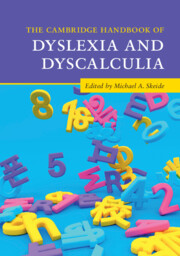Book contents
- The Cambridge Handbook of Dyslexia and Dyscalculia
- The Cambridge Handbook of Dyslexia and Dyscalculia
- Copyright page
- Contents
- Figures and Tables
- Contributors
- Acknowledgements
- General Introduction
- Part I Theoretical Frameworks and Computational Models
- Part II Cognitive Profiles and Behavioural Manifestations
- Part III Genetic and Environmental Influences
- Part IV Neurodevelopmental Foundations
- Part V Gender, Ethnicity, and Socioeconomic Background
- Part VI Cultural Unity and Diversity
- Part VII Early Prediction
- Part VIII Intervention and Compensation
- Part IX Best Practice – Diagnostics and Prevention
- Part X Best Practice – Schooling and Educational Policy
- General Summary
- References
- Index
General Introduction
Published online by Cambridge University Press: 28 July 2022
- The Cambridge Handbook of Dyslexia and Dyscalculia
- The Cambridge Handbook of Dyslexia and Dyscalculia
- Copyright page
- Contents
- Figures and Tables
- Contributors
- Acknowledgements
- General Introduction
- Part I Theoretical Frameworks and Computational Models
- Part II Cognitive Profiles and Behavioural Manifestations
- Part III Genetic and Environmental Influences
- Part IV Neurodevelopmental Foundations
- Part V Gender, Ethnicity, and Socioeconomic Background
- Part VI Cultural Unity and Diversity
- Part VII Early Prediction
- Part VIII Intervention and Compensation
- Part IX Best Practice – Diagnostics and Prevention
- Part X Best Practice – Schooling and Educational Policy
- General Summary
- References
- Index
Summary
Almost 150 years after Kussmaul’s documentation of ‘Wortblindheit’ (word blindness) (Kussmaul 1877) the scientific community has generated a number of different theories of dyslexia and dyscalculia. While these theories are still controversially discussed, the converging findings of longitudinal developmental research now allow us to draw an increasingly clear picture of the potential origins of these learning difficulties. At the same time, the common understanding of dyslexia and dyscalculia is blurred by persistent myths, such as the notion that dyslexia causes letters to appear out of order or that dyscalculia is a sign of reduced intelligence. Moreover, families, educators, and even specialized practitioners are often not sure how a specific learning disorder is validly diagnosed and which type of support children need to cope with their difficulties. Accordingly, the purpose of this handbook is to provide a developmentally grounded perspective on these topics by integrating findings from the life sciences and social sciences.
- Type
- Chapter
- Information
- Publisher: Cambridge University PressPrint publication year: 2022

